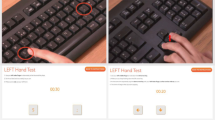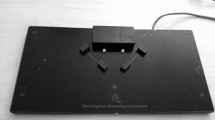Abstract
Huntington’s disease (HD) is a severe neurodegenerative condition in which the impairment in voluntary movement is related to functional disability. Clinical assessment of motor deficit currently relies largely on subjective rating scales without objective measurement. We have developed a quick and easy-to-use hand tapping device that enables measurement of (a) the number of taps in 30 seconds, (b) variability in tapping rhythm and (c) fatigue over the testing period. Initial cross-sectional testing of 178 consecutive HD clinic patients using an early model of the device showed that the total number of taps in 30 seconds correlated with the motor UHDRS (Spearmann’s rho, rs = –0.81, p < 0.0001) and independence scores (rs = 0.78, p = 0.01). Longitudinal data from a small cohort followed over 10 years reveals a correlation between total number of taps in 30 seconds and motor UHDRS over time (rs = –0.49, p < 0.001), and suggests the technique may provide an objective measure of disease progression. Further tests on 15 HD patients and 9 controls were repeated three times in a single day using an updated device. The HD group made significantly fewer taps in 30 seconds (median HD = 79, control = 104, p = 0.009) and had greater variability of inter-tap interval (mean interdecile range HD = 148, control = 56, p = 0.016) compared to controls. Both the total number of taps and variability of inter-tap interval correlated with motor UHDRS. Of vital importance for any potential marker of disease progression is that these tapping parameters were reproducible with repeated measurement. Given that hand tapping parameters differ between HD and control populations, they correlate with motor UHDRS over time and are reproducible, we propose that assessment of hand tapping represents a useful objective adjunct to the clinical assessment of HD patients.
Similar content being viewed by others
References
The Huntington’s Disease Collaborative Research Group (1993) A novel gene containing a trinucleotide repeat that is expanded and unstable on Huntington’s disease chromosomes. Cell 72:971–983
Huntington Study Group (1996) Unified Huntington’s Disease Rating Scale: reliability and consistency. Mov Disord 11:136–142
Andrich J, Saft C, Ostholt N, Muller T (2007) Assessment of simple movements and progression of Huntington’s disease. J Neurol Neurosurg Psychiatry 78:405–407
Bachoud-Levi AC, Maison P, Bartolomeo P, Boisse MF, Dalla BG, Ergis AM, Baudic S, Degos JD, Cesaro P, Peschanski M (2001) Retest effects and cognitive decline in longitudinal follow-up of patients with early HD. Neurology 56:1052–1058
Duyao M, Ambrose C, Myers R, Novelletto A, Persichetti F, Frontali M, Folstein S, Ross C, Franz M, Abbott M (1993) Trinucleotide repeat length instability and age of onset in Huntington’s disease. Nat Genet 4:387–392
Folstein SE, Jensen B, Leigh RJ, Folstein MF (1983) The measurement of abnormal movement: methods developed for Huntington’s disease. Neurobehav Toxicol Teratol 5:605–609
Garcia Ruiz PJ, Hernandez J, Cantarero S, Bartolome M, Sanchez B, Garcia dY (2002) Bradykinesia in Huntington’s disease. A prospective, follow-up study. J Neurol 249:437–440
Hinton SC, Paulsen JS, Hoffmann RG, Reynolds NC, Zimbelman JL, Rao SM (2007) Motor timing variability increases in preclinical Huntington’s disease patients as estimated onset of motor symptoms approaches. J Int Neuropsychol Soc 13(3):539–543
Kirkwood SC, Siemers E, Bond C, Conneally PM, Christian JC, Foroud T (2000) Confirmation of subtle motor changes among presymptomatic carriers of the Huntington disease gene. Arch Neurol 57:1040–1044
Langston JW, Widner H, Goetz CG, Brooks D, Fahn S, Freeman T, Watts R (1992) Core assessment program for intracerebral transplantations (CAPIT). Mov Disord 7:2–13
Li JY, Popovic N, Brundin P (2005) The use of the R6 transgenic mouse models of Huntington’s disease in attempts to develop novel therapeutic strategies. NeuroRx 2:447–464
Lin LI (1989) A concordance correlation coefficient to evaluate reproducibility. Biometrics 45:255–268
Lin LI (2000) A note on the concordance correlation coefficient. Biometrics 56:324–325
Quinn L, Reilmann R, Marder K, Gordon AM (2001) Altered movement trajectories and force control during object transport in Huntington’s disease. Mov Disord 16:469–480
Reilmann R, Kirsten F, Quinn L, Henningsen H, Marder K, Gordon AM (2001) Objective assessment of progression in Huntington’s disease: a 3-year follow-up study. Neurology 57:920–924
Rosenblatt A, Liang KY, Zhou H, Abbott MH, Gourley LM, Margolis RL, Brandt J, Ross CA (2006) The association of CAG repeat length with clinical progression in Huntington disease. Neurology 66(7):1016–1020
Saft C, Andrich J, Meisel NM, Przuntek H, Muller T (2006) Assessment of simple movements reflects impairment in Huntington’s disease. Mov Disord 21:1208–1212
Sanchez-Pernaute R, Kunig G, del Barrio AA, de Yebenes JG, Vontobel P, Leenders KL (2000) Bradykinesia in early Huntington’s disease. Neurology 54:119–125
Siemers E, Foroud T, Bill DJ, Sorbel J, Norton JA Jr, Hodes ME, Niebler G, Conneally PM, Christian JC (1996) Motor changes in presymptomatic Huntington disease gene carriers. Arch Neurol 53:487–492
van Vugt JP, Piet KK, Vink LJ, Siesling S, Zwinderman AH, Middelkoop HA, Roos RA (2004) Objective assessment of motor slowness in Huntington’s disease: clinical correlates and 2-year follow-up. Mov Disord 19:285–297
van Vugt JP, Siesling S, Piet KK, Zwinderman AH, Middelkoop HA, Van Hilten JJ, Roos RA (2001) Quantitative assessment of daytime motor activity provides a responsive measure of functional decline in patients with Huntington’s disease. Mov Disord 16: 481–488
Author information
Authors and Affiliations
Corresponding author
Additional information
*contributed equally to this paper
Rights and permissions
About this article
Cite this article
Michell, A.W., Goodman, A.O.G., Silva, A.H.D. et al. Hand tapping: A simple, reproducible, objective marker of motor dysfunction in Huntington’s disease. J Neurol 255, 1145–1152 (2008). https://doi.org/10.1007/s00415-008-0859-x
Received:
Revised:
Accepted:
Published:
Issue Date:
DOI: https://doi.org/10.1007/s00415-008-0859-x




